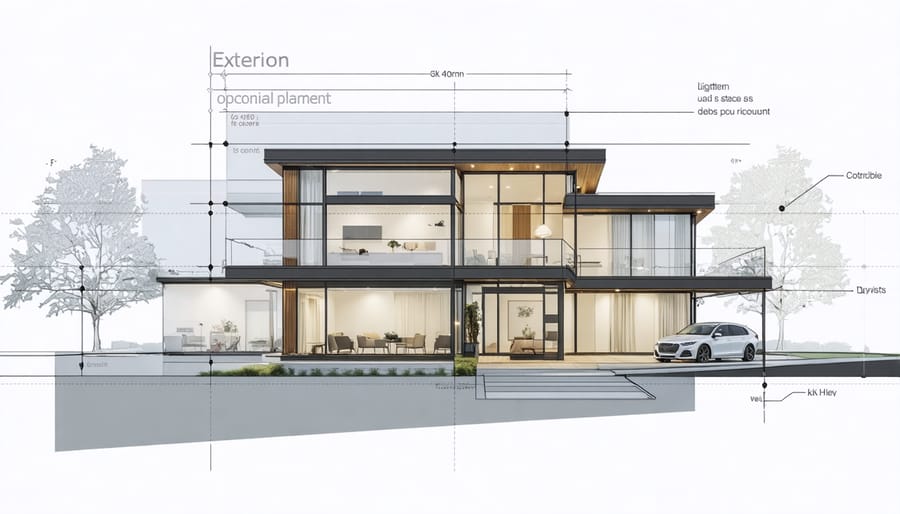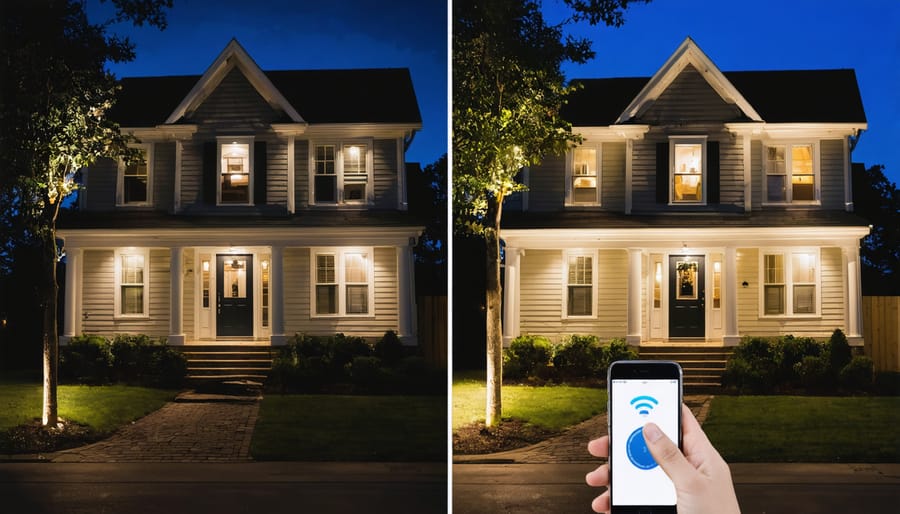Transform your outdoor lighting into an intelligent security and efficiency powerhouse with modern smart control systems. These innovative solutions revolutionize how we illuminate our eco-friendly outdoor spaces, offering unprecedented control through smartphone apps and automated scheduling.
Today’s smart outdoor lighting systems reduce energy consumption by up to 80% while enhancing home security and curb appeal. Motion sensors activate lights only when needed, while astronomical timers adjust to seasonal sunset changes automatically. Integration with smart home platforms like Alexa or Google Home transforms basic illumination into an intelligent ecosystem that responds to voice commands and weather conditions.
Gone are the days of manually switching outdoor lights or leaving them on accidentally. Smart lighting control systems represent the perfect blend of convenience, security, and energy efficiency – allowing homeowners to create the perfect ambiance while maintaining practical functionality. Whether illuminating pathways for safety, highlighting landscape features, or securing entry points, these systems offer customizable solutions that adapt to your lifestyle while reducing your carbon footprint and energy bills.
Why Your Current Outdoor Lighting Is Costing You Extra
Energy Waste Spots Most Homeowners Miss
Many homeowners focus on obvious energy-saving measures but overlook subtle lighting inefficiencies that can significantly impact their utility bills. A common oversight is leaving decorative path lights on at full brightness throughout the night when motion-sensing dimming would suffice. Poorly positioned flood lights often illuminate unnecessary areas, wasting energy while potentially disturbing neighbors. Another frequently missed issue is outdated timers that don’t adjust to seasonal changes, resulting in lights running longer than needed during summer months.
Creating energy-efficient outdoor designs starts with identifying these hidden energy drains. Check for lights aimed at reflective surfaces, which can create unnecessary light pollution and waste. Many homeowners also overlook deteriorating fixtures that consume more power while providing less illumination. Light fixtures exposed to the elements often develop seal problems, allowing moisture to affect performance and efficiency.
Don’t forget to inspect junction boxes and wiring connections, as poor electrical connections can lead to increased power consumption and potential safety hazards. Regular maintenance checks can help identify these issues before they become costly problems.

Security Gaps in Traditional Systems
Traditional outdoor lighting systems often leave homeowners vulnerable to several security risks that many don’t realize exist. Manual switches and basic timers can be predictable, making it easy for potential intruders to spot patterns in your lighting schedule. These systems typically lack real-time monitoring capabilities, meaning you might not know about malfunctioning lights until it’s too late.
Basic timer systems can also become unreliable over time, especially when power outages occur or seasonal changes require adjustments. Without remote access, homeowners can’t make immediate changes to their lighting when away from home, potentially leaving their property dark and exposed during unexpected late returns or early departures.
Another significant vulnerability lies in the inability to simulate realistic occupancy patterns. Static timing patterns make it obvious when no one’s home, and traditional systems can’t adapt to different situations or create varying light sequences that mimic natural human activity. Additionally, conventional systems often lack integration capabilities with other security features, creating potential gaps in your overall home protection strategy.
Smart Lighting Control Features That Matter
Motion Detection and Automation
Motion detection technology brings a new level of convenience and security to outdoor lighting systems. When someone approaches your property, integrated sensors automatically illuminate pathways, driveways, or entry points, providing both safety and energy efficiency. Most systems allow you to adjust sensitivity levels and detection zones to prevent false triggers from small animals or swaying branches.
Automated scheduling adds another layer of smart control to your outdoor lighting. You can program lights to turn on at sunset and off at sunrise, or create custom schedules that match your family’s routine. For example, set your front porch lights to dim at midnight but keep security lights at full brightness, or create “vacation mode” settings that simulate occupancy while you’re away.
Many modern systems now offer geofencing capabilities, which can automatically activate your lights when you approach home. This feature is particularly convenient when returning after dark with groceries or children. The best part? Most motion detection and scheduling features can be easily adjusted through user-friendly smartphone apps, allowing you to fine-tune your lighting preferences without climbing ladders or accessing complex control panels. These automated features not only enhance security but can significantly reduce energy consumption by ensuring lights operate only when needed.
Weather-Responsive Controls
Modern outdoor lighting control systems come equipped with sophisticated weather-responsive features that automatically adjust to environmental conditions. These smart systems use integrated weather sensors and real-time data to create sustainable outdoor lighting solutions that adapt to nature’s rhythms.
During rainfall or snow, the system can automatically increase brightness levels to improve visibility and safety. On clear nights with a full moon, it might dim the lights to conserve energy while maintaining adequate illumination. These adjustments happen seamlessly, requiring no manual intervention from homeowners.
Seasonal changes are also factored into the programming. The system tracks sunrise and sunset times throughout the year, automatically adjusting lighting schedules to match daylight hours. During winter months, lights activate earlier in the evening and stay on longer in the morning, while summer programming adapts to longer daylight hours.
Many systems also include frost detection capabilities, automatically activating pathway lights when temperatures drop below freezing to help prevent accidents on potentially icy surfaces. This weather-smart technology not only enhances safety but also optimizes energy usage, resulting in lower utility bills and reduced environmental impact.
Mobile App Integration
Modern outdoor smart lighting systems put complete control right at your fingertips through user-friendly mobile apps. These apps transform your smartphone into a powerful remote control center, allowing you to manage your entire outdoor lighting setup from anywhere with an internet connection.
Most apps offer intuitive features like creating custom lighting schedules, adjusting brightness levels, and setting up motion-activated security responses. You can group lights by zones, perfect for managing different areas of your property separately – from pathway lights to deck illumination.
Want to ensure your lights are off while you’re away on vacation? Simply check your app and make adjustments as needed. Many apps also send helpful notifications about power usage and maintenance needs, helping you stay on top of system care. Some even integrate with voice assistants like Alexa or Google Home for hands-free control.
The real beauty lies in the convenience – whether you’re relaxing on your couch or miles away from home, complete lighting control is always just a tap away.

Setting Up Your Smart Outdoor Lighting System
Planning Your Layout
Before installing your outdoor smart lighting system, take time to carefully map out your property and identify key areas that need illumination. Start by walking your property at night to spot dark zones and high-traffic areas that require consistent lighting. Consider dividing your outdoor space into distinct zones: entryways, pathways, landscaping features, and security-focused areas.
Create a simple sketch of your property and mark potential mounting locations for lights and sensors. Pay special attention to power source availability and Wi-Fi coverage in these areas. For optimal control, position motion sensors where they can detect movement without triggering false alarms from passing cars or swaying branches.
Think about how you’ll use different areas throughout the year. Entertaining spaces might need adjustable mood lighting, while security zones require consistent, bright illumination. Plan for seasonal changes by considering how foliage growth might affect light distribution and sensor functionality.
Don’t forget to account for existing electrical outlets and consider where you might need to add weather-protected power sources. Group lights that serve similar purposes into zones for easier control through your smart home app. This zoning approach allows you to create different lighting scenes for various occasions, from everyday security to special events.
Remember to leave room for future expansion of your system. Many homeowners find they want to add more features once they experience the convenience of smart lighting control.

Integration with Existing Systems
One of the best features of modern outdoor smart lighting systems is their ability to work seamlessly with your existing home automation setup. Most smart lighting controllers can integrate with popular platforms like Amazon Alexa, Google Home, and Apple HomeKit, allowing you to control your outdoor lights using voice commands or your smartphone.
To connect your outdoor lighting system, you’ll typically need to ensure your smart lights are compatible with your home’s automation hub. Many systems use standard protocols like Zigbee or Z-Wave, making integration straightforward. Once connected, you can create custom routines that coordinate your outdoor lights with other smart devices – for example, having your pathway lights turn on when your smart doorbell detects motion.
For the best results, look for lighting systems that offer an open API or direct compatibility with your existing setup. This allows you to create sophisticated automation scenarios, such as having your outdoor lights respond to your smart home’s away mode or synchronize with your indoor lighting scenes for a cohesive appearance throughout your property.
Maintenance and Troubleshooting
Regular maintenance of your outdoor smart lighting system ensures optimal performance and longevity. Start with a monthly visual inspection of fixtures, checking for water damage, loose connections, or debris accumulation. Clean light fixtures with a soft, damp cloth to remove dirt and spider webs that can affect light output.
Check your app or control system regularly for available firmware updates, as these often include important security patches and new features. Test motion sensors and timers monthly to ensure they’re responding correctly, and adjust sensitivity settings if needed.
If you encounter connectivity issues, first check your Wi-Fi signal strength in the installation area. Sometimes, simply resetting your hub or router can resolve connection problems. For unresponsive lights, verify that the bulbs are properly seated and that the power supply is functioning.
Battery-operated sensors and controls typically need replacement every 12-18 months. Keep spare batteries on hand and note when you last changed them. If your system shows unusual behavior or stops working altogether, try a complete power cycle before calling professional support. Most manufacturers offer troubleshooting guides through their apps or websites to help resolve common issues quickly.
Smart outdoor lighting control systems represent a significant step forward in how we manage our exterior spaces, offering a perfect blend of convenience, security, and efficiency. By implementing these innovative solutions, homeowners can transform their outdoor areas while making environmentally conscious outdoor improvements that benefit both their lifestyle and the planet.
The advantages of these systems are clear and compelling. From substantial energy savings through automated scheduling and motion detection to enhanced security features that deter unwanted visitors, smart outdoor lighting controls provide practical solutions to everyday challenges. The ability to control lighting from anywhere using a smartphone app adds unprecedented convenience, while integration with other smart home systems creates a seamless outdoor living experience.
Moreover, these systems prove their worth through reduced maintenance needs and extended bulb life, thanks to intelligent management of lighting usage. The initial investment in smart outdoor lighting controls typically pays for itself through lower energy bills and reduced replacement costs over time.
For homeowners considering this upgrade, the time to act is now. As technology continues to advance, these systems become more affordable and user-friendly with each passing year. Starting with a basic smart lighting setup and expanding over time allows for a manageable investment while immediately enjoying the benefits of automated outdoor lighting.
Remember that a well-planned smart lighting system does more than just illuminate your property – it creates ambiance, ensures safety, and adds value to your home while reducing your environmental footprint. By taking this step toward modernizing your outdoor space, you’re investing in a solution that will serve you well for years to come, making your home more efficient, secure, and enjoyable for everyone who lives there.





Leave a Reply